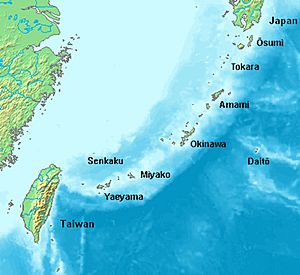Ryukyuan languages facts for kids
Quick facts for kids Ryukyuan |
|
|---|---|
| Ethnicity: | Ryukyuan people |
| Geographic distribution: |
Ryukyu Islands (Okinawa Prefecture, Amami Islands of Kagoshima Prefecture) |
| Linguistic classification: | Japonic
|
| Subdivisions: | |
 Location of Ryukyu Islands
|
|
The Ryukyuan languages (in Okinawan: 琉球口, Ruuchuuguchi) are a group of languages. They are part of the Japonic languages family. People speak them in the Ryūkyū Islands, which are the southernmost islands of Japan.
There are six main Ryukyuan languages: Amami, Kunigami, Okinawan, Miyako, Yaeyama, and Yonaguni.
Even though Japan considers them dialects of Japanese, most language experts (called linguists) see them as separate languages. This is because people who only speak Japanese would not understand Ryukyuan languages without learning them first.
In the past, many people across the Ryukyu Islands spoke these languages. However, over time, the Ryukyuan languages faced challenges. Because of this, most people in the Ryukyu Islands now speak Japanese instead.
Contents
How Ryukyuan Languages Began
Long ago, a group of people called the Yayoi came to Japan. They brought a language with them called Proto-Japonic. Over many years, this original language slowly changed. It split into two main branches: Japanese and the Ryukyuan languages. This is how they became different over time.
How Sounds Changed in Ryukyuan
Ryukyuan languages have different sounds compared to Japanese. This is because their sounds changed in unique ways. Let's look at some examples:
Sound Changes from Japanese "o"
In Japanese, the sound "o" often becomes "u" in Okinawan. For example, the Japanese word "to" (which means "and") is "tu" in Okinawan. This is a common change you can hear.
Sound Changes from Japanese "k"
Another interesting change is how the Japanese "k" sound can become "ch" in Okinawan. This is why the Japanese name "Okinawa" is often said as "Uchinaa" by Okinawan speakers.
Sound Changes from Japanese "y"
In the Yonaguni language, the Japanese "y" sound changes to a "d" sound. For instance, the Japanese word "yama" (meaning "mountain") is "dama" in Yonaguni. These sound changes show how languages evolve.
Who Speaks Ryukyuan Languages Today
Today, most older people in the Ryukyu Islands can still speak a Ryukyuan language. However, many younger people mostly speak Japanese.
You can also find Ryukyuan language speakers in other parts of the world. Many Ryukyuan people moved to places like Hawaii and South America. They continue to speak their languages there, keeping their culture alive.
Images for kids
See also
 In Spanish: Lenguas ryukyuenses para niños
In Spanish: Lenguas ryukyuenses para niños





